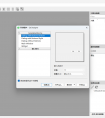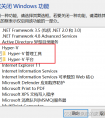前言,主要通过参考并总结两篇文章中的部分内容,参考文章一 && 参考文章二
Qt 设计师简单例子
一、需求分析二、界面设计三、生成ui文件四、ui文件转py文件1、命令行 执行 uic 生成 py代码2、PyCharm 配置 Pyuic工具2.1 配置Pyuic工具2.2 测试是否配置成功 五、运行ui文件所转的py文件六、功能实现1、编写代码2、运行代码
一、需求分析
新增一个用户注册界面,包含用户名,密码,性别,手机号,点击注册按钮时,弹出一个对话框,提示恭喜 “{用户输入的用户名}” 注册成功。但是无奈还没找出获取最新输入用户名的值,就简单做个例子,随意了。大家可以自己尝试。
二、界面设计
打开Qt Designer工具,如下图所示: 新建一个Main Window窗体,接着拖拉界面组件到Main Window窗体中,我这边拖拉好了,如下图所示:
新建一个Main Window窗体,接着拖拉界面组件到Main Window窗体中,我这边拖拉好了,如下图所示: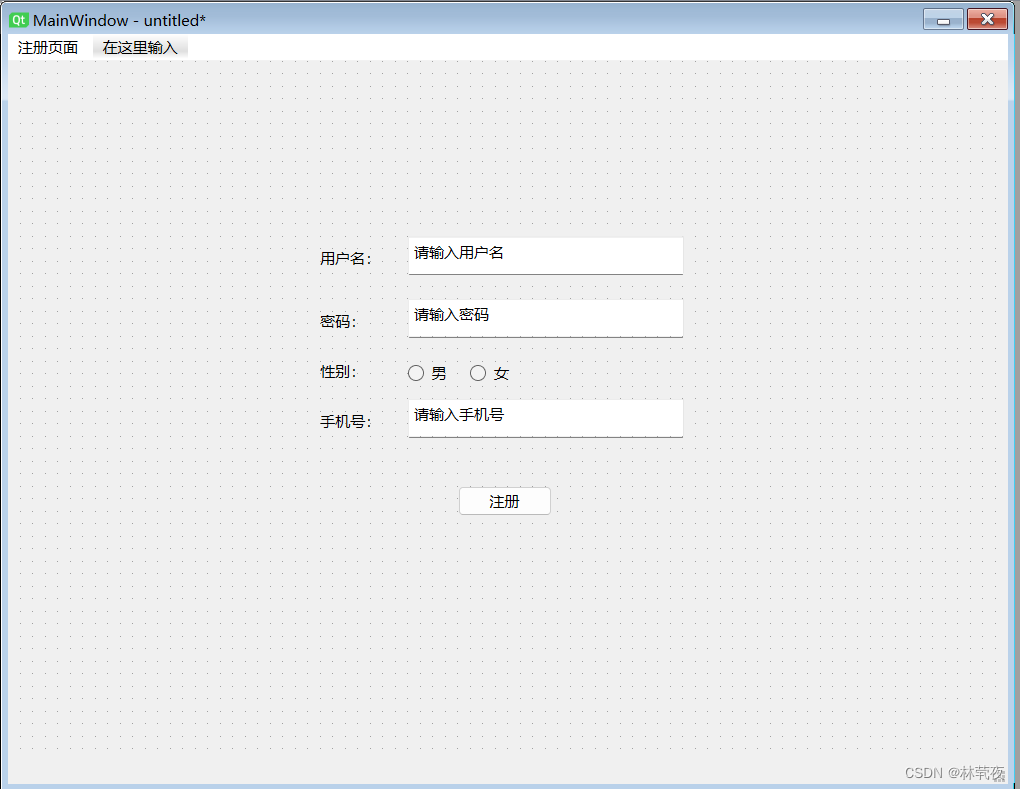
三、生成ui文件
接着ctrl+s保存ui文件,这边我保存到PyQt项目底下,并命名为register.ui文件,如下图所示:

接着新建一个ui包,在com.lyx包底下,把register.ui放进去,代码目录结构如下:

打开register.ui文件,内容是一个xml格式,帮我们自动生成了,突然觉得有点像大学时期学的android,代码如下:
<?xml version="1.0" encoding="UTF-8"?><ui version="4.0"> <class>MainWindow</class> <widget class="QMainWindow" name="MainWindow"> <property name="geometry"> <rect> <x>0</x> <y>0</y> <width>800</width> <height>600</height> </rect> </property> <property name="windowTitle"> <string>MainWindow</string> </property> <widget class="QWidget" name="centralwidget"> <widget class="QLabel" name="label"> <property name="geometry"> <rect> <x>250</x> <y>150</y> <width>54</width> <height>16</height> </rect> </property> <property name="text"> <string>用户名:</string> </property> </widget> <widget class="QTextEdit" name="textEdit"> <property name="geometry"> <rect> <x>320</x> <y>140</y> <width>221</width> <height>31</height> </rect> </property> <property name="html"> <string><!DOCTYPE HTML PUBLIC "-//W3C//DTD HTML 4.0//EN" "http://www.w3.org/TR/REC-html40/strict.dtd"><html><head><meta name="qrichtext" content="1" /><meta charset="utf-8" /><style type="text/css">p, li { white-space: pre-wrap; }hr { height: 1px; border-width: 0; }li.unchecked::marker { content: "\2610"; }li.checked::marker { content: "\2612"; }</style></head><body style=" font-family:'Microsoft YaHei UI'; font-size:9pt; font-weight:400; font-style:normal;"><p style=" margin-top:0px; margin-bottom:0px; margin-left:0px; margin-right:0px; -qt-block-indent:0; text-indent:0px;">请输入用户名</p></body></html></string> </property> </widget> <widget class="QLabel" name="label_2"> <property name="geometry"> <rect> <x>250</x> <y>200</y> <width>54</width> <height>16</height> </rect> </property> <property name="text"> <string>密码:</string> </property> </widget> <widget class="QTextEdit" name="textEdit_2"> <property name="geometry"> <rect> <x>320</x> <y>190</y> <width>221</width> <height>31</height> </rect> </property> <property name="html"> <string><!DOCTYPE HTML PUBLIC "-//W3C//DTD HTML 4.0//EN" "http://www.w3.org/TR/REC-html40/strict.dtd"><html><head><meta name="qrichtext" content="1" /><meta charset="utf-8" /><style type="text/css">p, li { white-space: pre-wrap; }hr { height: 1px; border-width: 0; }li.unchecked::marker { content: "\2610"; }li.checked::marker { content: "\2612"; }</style></head><body style=" font-family:'Microsoft YaHei UI'; font-size:9pt; font-weight:400; font-style:normal;"><p style=" margin-top:0px; margin-bottom:0px; margin-left:0px; margin-right:0px; -qt-block-indent:0; text-indent:0px;">请输入密码</p></body></html></string> </property> </widget> <widget class="QLabel" name="label_3"> <property name="geometry"> <rect> <x>250</x> <y>240</y> <width>54</width> <height>16</height> </rect> </property> <property name="text"> <string>性别:</string> </property> </widget> <widget class="QRadioButton" name="radioButton"> <property name="geometry"> <rect> <x>320</x> <y>240</y> <width>41</width> <height>20</height> </rect> </property> <property name="text"> <string>男</string> </property> </widget> <widget class="QRadioButton" name="radioButton_2"> <property name="geometry"> <rect> <x>370</x> <y>240</y> <width>51</width> <height>20</height> </rect> </property> <property name="text"> <string>女</string> </property> </widget> <widget class="QLabel" name="label_4"> <property name="geometry"> <rect> <x>250</x> <y>280</y> <width>54</width> <height>16</height> </rect> </property> <property name="text"> <string>手机号:</string> </property> </widget> <widget class="QTextEdit" name="textEdit_3"> <property name="geometry"> <rect> <x>320</x> <y>270</y> <width>221</width> <height>31</height> </rect> </property> <property name="html"> <string><!DOCTYPE HTML PUBLIC "-//W3C//DTD HTML 4.0//EN" "http://www.w3.org/TR/REC-html40/strict.dtd"><html><head><meta name="qrichtext" content="1" /><meta charset="utf-8" /><style type="text/css">p, li { white-space: pre-wrap; }hr { height: 1px; border-width: 0; }li.unchecked::marker { content: "\2610"; }li.checked::marker { content: "\2612"; }</style></head><body style=" font-family:'Microsoft YaHei UI'; font-size:9pt; font-weight:400; font-style:normal;"><p style=" margin-top:0px; margin-bottom:0px; margin-left:0px; margin-right:0px; -qt-block-indent:0; text-indent:0px;">请输入手机号</p></body></html></string> </property> </widget> <widget class="QPushButton" name="pushButton"> <property name="geometry"> <rect> <x>360</x> <y>340</y> <width>75</width> <height>24</height> </rect> </property> <property name="text"> <string>注册</string> </property> </widget> </widget> <widget class="QMenuBar" name="menuBar"> <property name="geometry"> <rect> <x>0</x> <y>0</y> <width>800</width> <height>22</height> </rect> </property> <property name="defaultUp"> <bool>false</bool> </property> <widget class="QMenu" name="menu"> <property name="title"> <string>注册页面 </string> </property> </widget> <addaction name="menu"/> </widget> <widget class="QStatusBar" name="statusbar"/> </widget> <resources/> <connections/></ui>四、ui文件转py文件
这种界面文件要应用到Python程序中,需要把它转成.py格式文件,有两种方式,但是实现都是通过pyuic。
第一种用命令行执行uic,第二种PyCharm配置pyuic,设置其运行程序、参数和工作目录,下面依次介绍:
1、命令行 执行 uic 生成 py代码
首先,进入刚才放置register.ui的目录,在终端执行命令:cd PyQt/com/lyx/uipython -m PyQt6.uic.pyuic register.ui -o register.py 代码如下:
代码如下: # Form implementation generated from reading ui file 'register.ui'## Created by: PyQt6 UI code generator 6.4.2## WARNING: Any manual changes made to this file will be lost when pyuic6 is# run again. Do not edit this file unless you know what you are doing.from PyQt6 import QtCore, QtGui, QtWidgetsclass Ui_MainWindow(object): def setupUi(self, MainWindow): MainWindow.setObjectName("MainWindow") MainWindow.resize(800, 600) self.centralwidget = QtWidgets.QWidget(parent=MainWindow) self.centralwidget.setObjectName("centralwidget") self.label = QtWidgets.QLabel(parent=self.centralwidget) self.label.setGeometry(QtCore.QRect(250, 150, 54, 16)) self.label.setObjectName("label") self.textEdit = QtWidgets.QTextEdit(parent=self.centralwidget) self.textEdit.setGeometry(QtCore.QRect(320, 140, 221, 31)) self.textEdit.setObjectName("textEdit") self.label_2 = QtWidgets.QLabel(parent=self.centralwidget) self.label_2.setGeometry(QtCore.QRect(250, 200, 54, 16)) self.label_2.setObjectName("label_2") self.textEdit_2 = QtWidgets.QTextEdit(parent=self.centralwidget) self.textEdit_2.setGeometry(QtCore.QRect(320, 190, 221, 31)) self.textEdit_2.setObjectName("textEdit_2") self.label_3 = QtWidgets.QLabel(parent=self.centralwidget) self.label_3.setGeometry(QtCore.QRect(250, 240, 54, 16)) self.label_3.setObjectName("label_3") self.radioButton = QtWidgets.QRadioButton(parent=self.centralwidget) self.radioButton.setGeometry(QtCore.QRect(320, 240, 41, 20)) self.radioButton.setObjectName("radioButton") self.radioButton_2 = QtWidgets.QRadioButton(parent=self.centralwidget) self.radioButton_2.setGeometry(QtCore.QRect(370, 240, 51, 20)) self.radioButton_2.setObjectName("radioButton_2") self.label_4 = QtWidgets.QLabel(parent=self.centralwidget) self.label_4.setGeometry(QtCore.QRect(250, 280, 54, 16)) self.label_4.setObjectName("label_4") self.textEdit_3 = QtWidgets.QTextEdit(parent=self.centralwidget) self.textEdit_3.setGeometry(QtCore.QRect(320, 270, 221, 31)) self.textEdit_3.setObjectName("textEdit_3") self.pushButton = QtWidgets.QPushButton(parent=self.centralwidget) self.pushButton.setGeometry(QtCore.QRect(360, 340, 75, 24)) self.pushButton.setObjectName("pushButton") MainWindow.setCentralWidget(self.centralwidget) self.menuBar = QtWidgets.QMenuBar(parent=MainWindow) self.menuBar.setGeometry(QtCore.QRect(0, 0, 800, 22)) self.menuBar.setDefaultUp(False) self.menuBar.setObjectName("menuBar") self.menu = QtWidgets.QMenu(parent=self.menuBar) self.menu.setObjectName("menu") MainWindow.setMenuBar(self.menuBar) self.statusbar = QtWidgets.QStatusBar(parent=MainWindow) self.statusbar.setObjectName("statusbar") MainWindow.setStatusBar(self.statusbar) self.menuBar.addAction(self.menu.menuAction()) self.retranslateUi(MainWindow) QtCore.QMetaObject.connectSlotsByName(MainWindow) def retranslateUi(self, MainWindow): _translate = QtCore.QCoreApplication.translate MainWindow.setWindowTitle(_translate("MainWindow", "MainWindow")) self.label.setText(_translate("MainWindow", "用户名:")) self.textEdit.setHtml(_translate("MainWindow", "<!DOCTYPE HTML PUBLIC \"-//W3C//DTD HTML 4.0//EN\" \"http://www.w3.org/TR/REC-html40/strict.dtd\">\n""<html><head><meta name=\"qrichtext\" content=\"1\" /><meta charset=\"utf-8\" /><style type=\"text/css\">\n""p, li { white-space: pre-wrap; }\n""hr { height: 1px; border-width: 0; }\n""li.unchecked::marker { content: \"\\2610\"; }\n""li.checked::marker { content: \"\\2612\"; }\n""</style></head><body style=\" font-family:\'Microsoft YaHei UI\'; font-size:9pt; font-weight:400; font-style:normal;\">\n""<p style=\" margin-top:0px; margin-bottom:0px; margin-left:0px; margin-right:0px; -qt-block-indent:0; text-indent:0px;\">请输入用户名</p></body></html>")) self.label_2.setText(_translate("MainWindow", "密码:")) self.textEdit_2.setHtml(_translate("MainWindow", "<!DOCTYPE HTML PUBLIC \"-//W3C//DTD HTML 4.0//EN\" \"http://www.w3.org/TR/REC-html40/strict.dtd\">\n""<html><head><meta name=\"qrichtext\" content=\"1\" /><meta charset=\"utf-8\" /><style type=\"text/css\">\n""p, li { white-space: pre-wrap; }\n""hr { height: 1px; border-width: 0; }\n""li.unchecked::marker { content: \"\\2610\"; }\n""li.checked::marker { content: \"\\2612\"; }\n""</style></head><body style=\" font-family:\'Microsoft YaHei UI\'; font-size:9pt; font-weight:400; font-style:normal;\">\n""<p style=\" margin-top:0px; margin-bottom:0px; margin-left:0px; margin-right:0px; -qt-block-indent:0; text-indent:0px;\">请输入密码</p></body></html>")) self.label_3.setText(_translate("MainWindow", "性别:")) self.radioButton.setText(_translate("MainWindow", "男")) self.radioButton_2.setText(_translate("MainWindow", "女")) self.label_4.setText(_translate("MainWindow", "手机号:")) self.textEdit_3.setHtml(_translate("MainWindow", "<!DOCTYPE HTML PUBLIC \"-//W3C//DTD HTML 4.0//EN\" \"http://www.w3.org/TR/REC-html40/strict.dtd\">\n""<html><head><meta name=\"qrichtext\" content=\"1\" /><meta charset=\"utf-8\" /><style type=\"text/css\">\n""p, li { white-space: pre-wrap; }\n""hr { height: 1px; border-width: 0; }\n""li.unchecked::marker { content: \"\\2610\"; }\n""li.checked::marker { content: \"\\2612\"; }\n""</style></head><body style=\" font-family:\'Microsoft YaHei UI\'; font-size:9pt; font-weight:400; font-style:normal;\">\n""<p style=\" margin-top:0px; margin-bottom:0px; margin-left:0px; margin-right:0px; -qt-block-indent:0; text-indent:0px;\">请输入手机号</p></body></html>")) self.pushButton.setText(_translate("MainWindow", "注册")) self.menu.setTitle(_translate("MainWindow", "注册页面 "))2、PyCharm 配置 Pyuic工具
2.1 配置Pyuic工具
在 " File —> Settings —> Tools —> External Tools " 中点击 + 号,添加外部工具。Name 填写为 “Py_UIC”,这个名字可以随意填"Program"中填入 “python.exe” 的路径。“Arguments” 中填入-m PyQt6.uic.pyuic $FileName$ -o $FileNameWithoutExtension$.py说明:-m 参数就是 “将 库模块 作为脚本运行”,这里库模块是 PyQt6.uic.pyuic,-o 参数是输出文件名“Working directory” 中填入
$FileDir$说明:
$FileDir$为系统自定义宏参数( 点击 宏参数 时 可以实时显示对应当前工程 的 值 ),如下图所示: 所有配置如下图所示:
所有配置如下图所示:
2.2 测试是否配置成功
首先,先把刚才命令行生成的register.py文件删除接着,.ui文件 —> 右键 -> External Tools —> Py_UIC,即可自动生成 py 文件,如下图所示,配置成功:
五、运行ui文件所转的py文件
首先,在test包底下,新建一个register_test.py文件,代码如下:import sysfrom PyQt6 import QtWidgetsfrom PyQt.com.lyx.ui.register import Ui_MainWindowif __name__ == '__main__': app = QtWidgets.QApplication(sys.argv) # 创建一个QApplication,也就是你要开发的应用程序 mainWindow = QtWidgets.QMainWindow() # 创建一个QMainWindow,用来装载你需要的各种组件、控件 ui = Ui_MainWindow() # ui是你创建的ui类的实例化对象,这里调用的便是刚才生成的register.py中的Ui_MainWindow类 ui.setupUi(mainWindow) # 执行类中的setupUi方法,方法的参数是第二步中创建的QMainWindow mainWindow.show() # 执行QMainWindow的show()方法,显示这个QMainWindow sys.exit(app.exec()) # 使用exit()或者点击关闭按钮退出QApplication
六、功能实现
1、编写代码
首先,在test包底下,新建一个my_window_test.py文件,重新写一个class来实现界面需要的逻辑,代码如下:import sysfrom PyQt.com.lyx.ui.register import Ui_MainWindowfrom PyQt6.QtWidgets import QMessageBox, QMainWindow, QApplication# 自定义窗口类# 参数1: QMainWindow 用来装载你需要的各种组件、控件# 参数2: Ui_MainWindow 通过Qt设计师生成的register.py的窗口类class MyWindow(QMainWindow, Ui_MainWindow): def __init__(self, parent=None): """ 子类的初始化方法,继承QMainWindow父类 :param parent: """ QMainWindow.__init__(self, parent=parent) # 初始化QMainWindow方法 self.setupUi(self) # 调用Ui_MainWindow类的setupUi方法,即register.py底下的setupUi方法,从中获取Ui界面 user_name = self.textEdit.toPlainText() # 获取UI底下的第一个文本框的名称,即用户名,作为参数点击按钮时传递过去 self.pushButton.clicked.connect(lambda: self.btnClicked(user_name)) # 注册按钮点击绑定事件,并调用btnClicked方法 def btnClicked(self, user_name): """ 点击注册按钮时触发事件 :param user_name: 用户名 :return: 显示一个对话框,展示用户名注册成功,对话框标题为对话框您好 """ msg = f'恭喜 {user_name},注册成功' # 显示信息,参数变量由{}括起来 self.statusBar().showMessage(msg) # 对话框设置信息 QMessageBox.information(self, '对话框您好', msg) # 生成对话框# main 主程序调用方法if __name__ == '__main__': app = QApplication(sys.argv) # 生成一个QApplication应用 MyWindow = MyWindow() # 实例化MyWindow对象 MyWindow.show() # 展示MyWindow对话框 sys.exit(app.exec()) # 使用exit()或者点击关闭按钮退出QApplication2、运行代码
运行后,如下图所示:
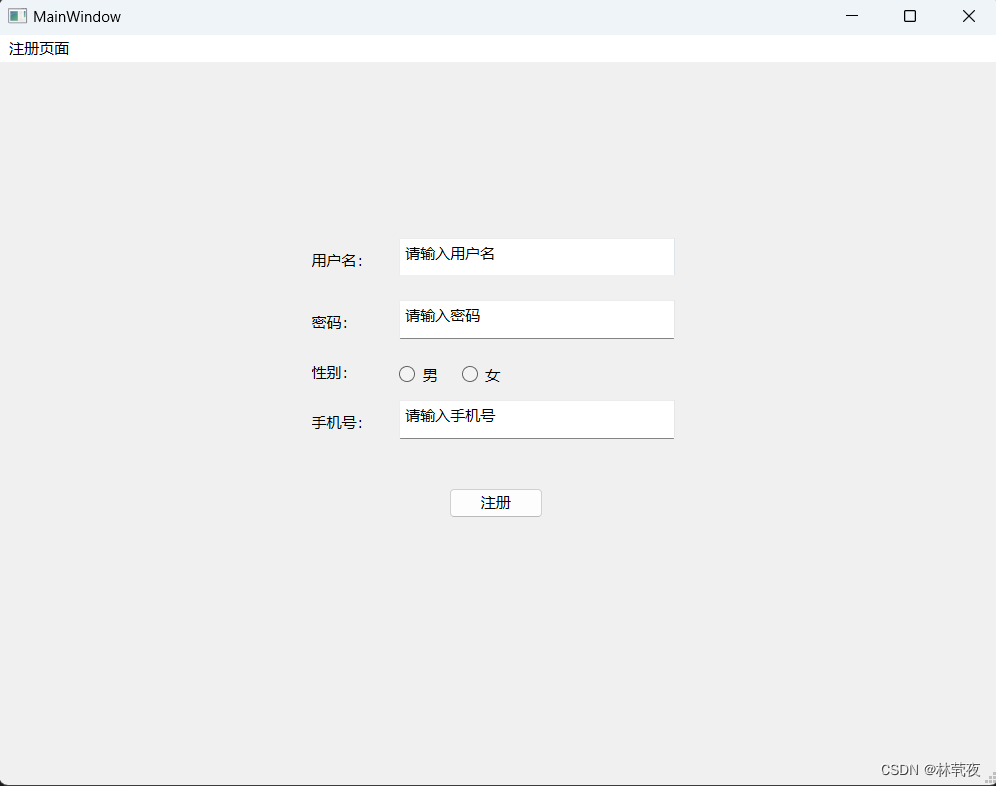
接着点击注册按钮,效果如下:
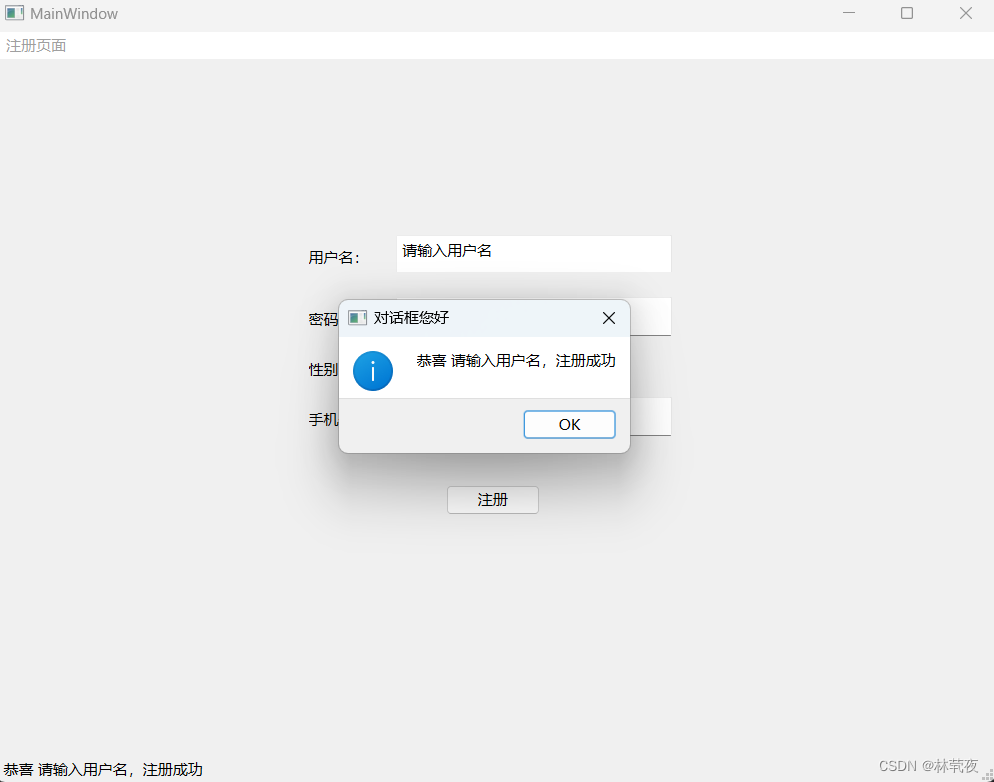
以上内容仅供学习参考,写得不好,敬请见谅。
